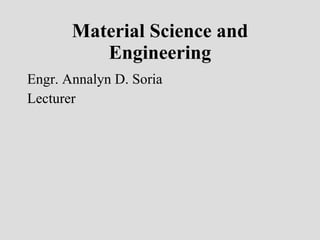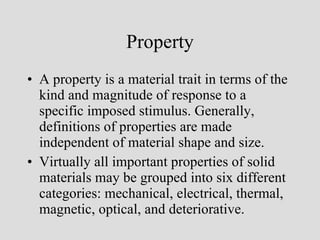Lecture 1 introduction
- 1. Material Science and Engineering Engr. Annalyn D. Soria Lecturer
- 2. INTRODUCTION
- 3. HISTORICAL PERSPECTIVE Stone -> Bronze -> Iron -> Advanced Materials Beginning of the Material Science - People began to make tools from stone – Start of the Stone Age about two million years ago. Natural materials: stone, wood, clay, skins, etc.
- 4. Historical Perspective The Stone Age ended about 5000 years ago with introduction of Bronze in the Far East. Bronze is an alloy (a metal made up of more than one element), copper + < 25% of tin + other elements. Bronze: can be hammered or cast into a variety of shapes, can be made harder by alloying, corrode only slowly after a surface oxide film forms.
- 5. Historical Perspective The Iron Age began about 3000 years ago and continues today. Use of iron and steel, a stronger and cheaper material changed drastically daily life of a common person. Age of Advanced materials: throughout the Iron Age many new types of materials have been introduced (ceramic, semiconductors, polymers, composites…).
- 6. Historical Perspective Understanding of the relationship among structure, properties, processing, and performance of materials. Intelligent design of new materials evolved. A better understanding of structure-composition properties relations has lead to a remarkable progress in properties of materials. Example is the dramatic progress in the strength to density ratio of materials, that resulted in a wide variety of new products, from dental materials to tennis racquets.
- 7. Figure from: M. A. White, Properties of Materials (Oxford University Press, 1999)
- 8. MATERIAL SCIENCE AND ENGINEERING Material science is the investigation of the relationship among processing, structure, properties, and performance of materials. Materials engineering is on the basis of these structure–property correlations, designing or engineering the structure of a material to produce a predetermined set of properties.
- 10. Structure the structure of a material usually relates to the arrangement of its internal components Subatomic level- Electronic structure of individual atoms that defines interaction among atoms (interatomic bonding) and with their nuclei.
- 11. Atomic level- Arrangement of atoms or molecules in materials relative to one another. (for the same atoms can have different properties, e.g. two forms of carbon: graphite and diamond).
- 12. Microscopic structure- Arrangement of small grains of material that can be identified by microscopy. And it is a larger structure, which contains large groups of atoms that are normally agglomerated together.
- 13. Macroscopic structure- Structural elements that may be viewed with the naked eye.
- 14. Property A property is a material trait in terms of the kind and magnitude of response to a specific imposed stimulus. Generally, definitions of properties are made independent of material shape and size. Virtually all important properties of solid materials may be grouped into six different categories: mechanical, electrical, thermal, magnetic, optical, and deteriorative.
- 15. Mechanical properties relate deformation to an applied load or force; examples include elastic modulus and strength. Electrical properties, such as electrical conductivity and dielectric constant, the stimulus is an electric field. Thermal behaviorof solids can be represented in terms of heat capacity and thermal conductivity.
- 16. Magnetic properties demonstrate the response of a material to the application of a magnetic field. Optical properties, the stimulus is electromagnetic or light radiation; index of refraction and reflectivity are representative optical properties. Deteriorative characteristics relate to the chemical reactivity of materials
- 17. Processing and Performance. With regard to the relationships of these four components, the structure of a material will depend on how it is processed. Furthermore, a material’s performance will be a function of its properties.
- 22. CLASSIFICATION OF MATERIALS Metals: valence electrons are detached from atoms, and spread in an 'electron sea' that "glues" the ions together. Strong, ductile, conduct electricity and heat well, are shiny if polished. Materials in this group are composed of one or more metallic elements (such as iron, aluminum, copper, titanium, gold, and
- 23. nickel), and often also nonmetallic elements (for example, carbon, nitrogen, and oxygen) in relatively small amounts. Atoms in metals and their alloys are arranged in a very orderly manner and in comparison to the ceramics and polymers, are relatively dense.
- 24. With regard to mechanical characteristics, these materials are relatively stiff and strong yet are ductile (i.e., capable of large amounts of deformation without fracture), and are resistant to fracture which accounts for their widespread use in structural applications.
- 25. Metals are extremely good conductors of electricity and heat, and are not transparent to visible light; a polished metal surface has a lustrous appearance. In addition, some of the metals (viz., Fe, Co, and Ni) have desirable magnetic properties.
- 27. Ceramics Ceramics are compounds between metallic and nonmetallic elements; they are most frequently oxides, nitrides, and carbides. some of the common ceramic materials include aluminum oxide (or lumina,Al2O3), silicon dioxide (or silica, SiO2), silicon carbide (SiC), silicon nitride (Si3N4)
- 28. in addition, what some refer to as the traditional ceramics—those composed of clay minerals (i.e., porcelain), as well as cement, and glass. With regard to mechanical behavior, ceramic materials are relatively stiff and strong—stiffnesses and strengths are comparable to those of the metals.
- 29. ceramics are typically very hard. On the other hand, they are extremely brittle (lack ductility), and are highly susceptible to fracture. These materials are typically insulative to the passage of heat and electricity (i.e., have low electrical conductivities, and are more resistant to high temperatures and
- 30. harsh environments than metals and polymers. With regard to optical characteristics, ceramics may be transparent, translucent, or opaque and some of the oxide ceramics (e.g., Fe3O4) exhibit magnetic behavior.
- 32. Polymers Polymers include the familiar plastic and rubber materials. Many of them are organic compounds that are chemically based on carbon, hydrogen, and other nonmetallic elements (viz.O,N, and Si). they have very large molecular structures, often chain-like in nature that have a backbone of carbon atoms.
- 33. Some of the common and familiar polymers are polyethylene (PE), nylon, poly(vinyl chloride) (PVC), polycarbonate (PC), polystyrene (PS), and silicone rubber. These materials typically have low densities whereas their mechanical characteristics are generally dissimilar to the metallic and ceramic materials—they are not as stiff nor as strong as these other material types
- 34. many of the polymers are extremely ductile and pliable (i.e., plastic), which means they are easily formed into complex shapes. they are relatively inert chemically and unreactive in a large number of environments.
- 35. One major drawback to the polymers is their tendency to soften and/or decompose at modest temperatures, which, in some instances, limits their use. they have low electrical conductivities and are nonmagnetic
- 37. Bar-chart of room temperature density values for various metals, ceramics, polymers, and composite materials.
- 42. Composites A composite is composed of two (or more) individual materials, which come from metals, ceramics, and polymers. The design goal of a composite is to achieve a combination of properties that is not displayed by any single material, and also to incorporate the best characteristics of each of the component materials.
- 43. One of the most common and familiar composites is fiberglass, in which small glass fibers are embedded within a polymeric material (normally an epoxy or polyester).
- 44. ADVANCED MATERIALS Materials that are utilized in high-technology (or high-tech) applications. Examples include electronic equipment (camcorders, CD/DVD players, etc.), computers, fiber-optic systems, spacecraft, aircraft, and military rocketry.
- 45. they may be of all material types (e.g., metals, ceramics, polymers), and are normally expensive. Advanced materials include semiconductors, biomaterials, and what we may term “materials of the future”
- 46. Semiconductors Semiconductors have electrical properties that are intermediate between the electrical conductors (metals and metal alloys) and insulators (ceramics and polymers) the electrical characteristics of these materials are extremely sensitive to the presence of minute concentrations of impurity atoms, for which the
- 47. concentrations may be controlled over very small spatial regions. the electrical characteristics of these materials are extremely sensitive to the presence of minute concentrations of impurity atoms, for which the concentrations may be controlled over very small spatial regions.
- 48. Semiconductors have made possible the advent of integrated circuitry that has totally revolutionized the electronics and computer industries
- 49. Biomaterials Biomaterials are employed in components implanted into the human body for replacement of diseased or damaged body parts. These materials must not produce toxic substances and must be compatible with body tissues
- 50. Materials of the Future Smart Materials- group of new and state-of-the-art materials now being developed that will have a significant influence on many of our technologies. Components include some type of sensor and an actuator. Four types of materials are commonly used for actuators: shape memory alloys, piezoelectric ceramics, magnetostrictive materials, and electrorheological/magnetorheological fluids.
- 51. Shape memory alloys are metals that, after having been deformed, revert back to their original shapes when temperature is changed. Piezoelectric ceramics expand and contract in response to an applied electric field (or voltage); conversely, they also generate an electric field when their dimensions are altered The behavior of magnetostrictive materials is analogous to that of the piezoelectrics, except
- 52. that they are responsive to magnetic fields. - Also, electrorheological and magnetorheological fluids are liquids that experience dramatic changes in viscosity upon the application of electric and magnetic fields, respectively. -
- 53. Materials/devices employed as sensors include optical fibers, piezoelectric materials (including some polymers), and microelectromechanical devices. Nanoengineered Materials - the dimensions of these structural entities are on the order of a nanometer
- 54. MODERN MATERIALS’ NEEDS development of even more sophisticated and specialized materials, as well as consideration of the environmental impact of materials production. Materials which reduces the weight of transportation vehicles (automobiles, aircraft, trains, etc.), as well as increasing engine operating temperatures, will enhance fuel efficiency.





















































